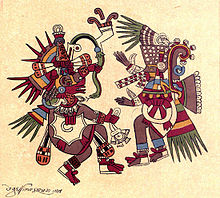Tezcatlipoca
![]()
This article is about the god Tezcatlipoca. For the asteroid of the same name, see (1980) Tezcatlipoca.
Tezcatlipoca was the god of night and matter of the Toltecs and the Aztecs. He is also called the "Smoking Mirror" because he is depicted with his magic mirror, with which he looks into the hearts and into the future. Other attributes were his sacrificial knife made of obsidian and his jaguar robe.
Tezcatlipoca was the god of the north, the cold, the night sky including moon and stars, the color black, matter, war, heroes, temptation and beautiful women.
Tezcatlipoca was involved in the creation of the world at the time of the first sun. His opponent Quetzalcoatl destroyed this world, but later Tezcatlipoca drove him out of Tollan/Tula.
Once Tezcatlipoca seduced the flower goddess Xochiquetzal, the sister of Xochipilli.
From the Historia general de las cosas de Nueva España by Bernardino de Sahagún comes the following text about Tezcatlipoca:
"The god Tezkatlipoka, he was considered a true god, invisible, powerful to enter any place, the heavens, the earth and the place of the dead. It was said that when he was on earth, he incited people to war, created enmity and discord, and caused much fear and unrest. He incited the nations against each other so that they waged wars, and that is why he was called the 'enemy on both sides'. He alone understood how to govern the world, and he alone bestowed wealth and riches and took them away at his pleasure; he bestowed riches, wealth and fame, valour and dominion, honours and dignities, and took them away again when it pleased him. Therefore he was feared and reverenced, for it was in his power to exalt and to cast down."
The asteroid (1980) Tezcatlipoca was also named after the deity Tezcatlipoca.
One of the most important ceremonies of the Aztec religion was the sacrifice of a youth, symbolizing Tezcatlipoca. A youth offered himself for sacrifice, was worshipped as a god for a year, and during this time played the flute in the streets. At the end of the year, he had to climb the steps to the temple and break four flutes that symbolized the cardinal points. Finally, he lay down on the sacrificial stone, where his heart was cut out.

Quetzalcoatl and Tezcatlipoca
Trivia
Tezcatlipoca and its relics, the Obsidian Blade and the Smoking Mirror, are the subject of the main storyline in the adventure game Baphomet's Curse 2.
Questions and Answers
Q: What is Tezcatlipocaus?
A: Tezcatlipocaus was a central deity in Aztec mythology.
Q: What are some of the concepts associated with Tezcatlipocaus?
A: Some of the concepts associated with Tezcatlipocaus were the night sky, the night winds, hurricanes, the north, the earth, obsidian, enmity, discord, rulership, divination, temptation, sorcery, beauty war and strife.
Q: How is his name translated in Nahuatl?
A: His name in Nahuatl is often translated as "Smoking Mirror" because of his connection to obsidian.
Q: How was he usually depicted in pictures?
A: He was usually drawn with a black and yellow stripe painted across his face. He is often shown with his right foot replaced with an obsidian mirror or a snake - an allusion to the creation myth in which he loses his foot battling with the Earth Monster. Sometimes the mirror was shown on his chest and sometimes smoke would come from it.
Q: What was Tezcatlipoca's animal counterpart?
A: His animal counterpart was called Nagual and it was a jaguar. His Jaguar aspect was known as Tepeyollotl "Mountainheart".
Q: Are there any similarities between him and other Mesoamerican deities?
A: Yes there are similarities between him and other Mesoamerican deities such as those worshipped by Olmecs and Maya people. For example Tohil from Popol Vuh whose name means "obsidian" and who was associated with sacrifice; God K or Manikin Scepter from Classic Maya who had smoking obsidian knife in forehead and one leg replaced with snake; etc.
Search within the encyclopedia